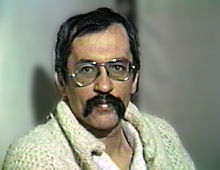
Born: August 24, 1944, Curitiba, Brazil
Died: June 7, 1989, Curitiba, Brazil
Early days. He was a son of a Polish-Brazilian father Paulo Leminski II and an African-Brazilian mother Aurea Pereira Mendes. From 1956 till 1958 he lived in the monastery Mosteiro de São Bento in Sao Paulo where he got basic knowledge of Latin, theology, philosophy and classical literature. Later he studied law and literature at a university but interrupted the studies because of the military coup of 1964.
Career. His first poems were published in 1964. His first small-press collection came out in the late 1970s. Although he never finished college, by the 1980s he knew Japanese, French, and English well enough to do translations. His most noted renderings are of Alfred Jarry, James Joyce, John Fante, John Lennon, Samuel Beckett, and Yukio Mishima. He also translated into Portuguese poems from Old-egyptian, Aztek and Sanskrit. He also helped to produce a number of albums and was said to have taught judo. Leminski was a prolific poet, wrote experimental prose / essays, occasionally wrote songs, and was a cultural agitator. He was the leading voice of his generation, having followed different paths of Brazilian lyric from the early 1960s through the late 1980s. His style of poetry has been compared to that of American poet E. E. Cummings (song writer / singer Luciana Souza on the Tom Schanbel show on KCRW 89.9 fm 24 June 2009). He contributed to the journal Invenção, while still a teen and would maintain a strong sense of visuality and layout in his poetic output. Some of Leminski's poetry of the late 1970s/early 1980s has been linked to the controversial labe of poesia marginal. But his dedication to resolution in language set him apart. His collections Caprichos & Relaxos (1983) and Distraídos venceremos (1987) are landmarks. In the latter, his rigor and intertextual urges are clear. A neo-baroque narrative, Catatau (1975), has become a cult book. His home town Curitiba has sponsored a yearly celebration of his legacy and cultural vibrancy in Brazil. The event's name Perhappiness is taken from a one-liner by the poet. There is a concise appreciation of the poet in Charles A. Perrone _Seven Faces: Brazilian Poetry since Modernism_ (Duke U P, 1996). Perrone, Chris Daniels, and others have translated Leminski.
Private. In 1961 he married an artist Neiva Maria de Sousa whom he divorced in 1968 and married a poet Alice Ruiz.
This article uses mostly material from the Wikipedia article "Paulo Leminski." Text is available under the Creative Commons Attribution-ShareAlike License; additional terms may apply. :
Wikipedia
Wikipedia in Portuguese (includes list of works)
Return to home page:
Prominent Poles